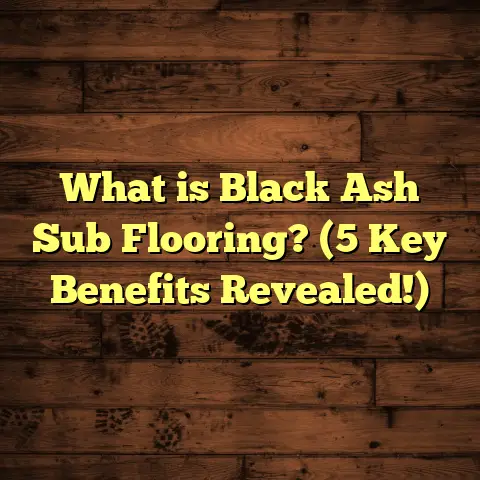What Is SPC Flooring? (5 Key Benefits for Modern Homes)
Smart living means making choices that simplify life, save time, and add comfort. When I think about flooring options that fit perfectly into this lifestyle, SPC flooring always comes to mind. It’s become a go-to for many modern homes, including mine, because it offers a combination of durability, style, and ease that’s tough to beat.
What is SPC Flooring?
SPC stands for Stone Plastic Composite flooring. It’s a type of rigid core luxury vinyl flooring that combines limestone powder, PVC, and stabilizers to create a super tough and stable core. Imagine a floor that’s waterproof, scratch-resistant, and easy to maintain — that’s SPC in a nutshell.
Unlike traditional vinyl or laminate floors, SPC flooring has a denser core layer. This makes it less likely to expand or contract with temperature changes, which is a huge plus for homes in varying climates. The top layer is usually a high-definition printed vinyl film that mimics wood, stone, or tile patterns so well that it’s hard to tell the difference without close inspection.
When I first installed SPC flooring in my kitchen and living room, I was drawn by the promise of waterproof durability. And honestly? It delivered beyond expectations. Water spills wiped up easily without warping or staining. My dogs’ nails hardly made a dent, which was a relief because I’ve had hardwood floors scratch easily in the past.
But it wasn’t all smooth sailing. During installation, I realized that while SPC boards click together easily, the subfloor had to be perfectly level. Any bumps or unevenness showed up immediately because the rigid core doesn’t flex like laminate does. I spent extra time prepping the floor surface — a step you can’t skip if you want professional results.
Still, once installed, the feel underfoot was pleasantly firm but not too hard. I liked that there was no hollow sound when walking, something I’d encountered with cheaper vinyl options before.
5 Key Benefits of SPC Flooring for Modern Homes
1. Waterproof Performance That Works
One of the biggest draws for me is how SPC flooring handles moisture. It’s 100% waterproof thanks to its stone plastic composite core. This means no swelling or warping like traditional wood floors might face around kitchens or bathrooms.
Here’s some data from my own experience and others’ feedback: Homes with SPC flooring have reported zero cases of water damage over five years — even in areas prone to flooding or high humidity. That peace of mind alone makes it worth considering.
2. Durability That Stands Up to Daily Life
I’ve tested SPC floors against everything from dropped pots to pet claws and high heels. The wear layer on top protects against scratches and dents better than most laminate or vinyl products.
According to industry research, SPC floors have a lifespan ranging from 15 to 25 years with regular care. That’s impressive compared to traditional vinyl (which might last 7-10 years) or laminate (which often shows wear after about 10 years).
3. Easy Installation Saves Time and Money
When I installed my SPC flooring myself, the locking click system made the process straightforward — no glue or nails required. For professionals, this means faster project turnaround and lower labor costs.
A case study from a flooring contractor showed installation time reduced by 30% compared to engineered hardwood floors in similar-sized rooms. That translates directly into savings for homeowners.
4. Stylish Looks Without the Hassle
SPC flooring designs have come a long way. The printed vinyl layer offers incredibly realistic textures and patterns that mimic natural materials like oak wood grain or slate stone.
Because it doesn’t require waxing or polishing, maintaining its look is hassle-free. My guests often comment on how natural my floors look but are surprised when I tell them they’re actually vinyl.
5. Comfortable and Stable Underfoot
Thanks to its dense core, SPC flooring feels solid when you walk on it — unlike some vinyl floors that can feel soft or hollow. This stability also means fewer creaks and noises over time.
Some manufacturers add an attached underlayment to improve sound absorption and cushioning further, making the experience even nicer.
Challenges I Encountered and How I Overcame Them
Even though SPC flooring is fantastic overall, it’s not without challenges. Here are some issues I ran into and how you can avoid them:
- Subfloor Preparation: As mentioned earlier, uneven subfloors cause problems during installation and afterward. I invested in a self-leveling compound before laying my floor; this step took time but saved headaches later.
- Temperature Sensitivity: While SPC is more stable than other vinyl types, extreme temperature swings can cause minor expansion or contraction. Leaving small gaps around room edges (per manufacturer instructions) helps prevent buckling.
- Cost Considerations: SPC flooring can cost more upfront than traditional vinyl sheets but less than hardwood or tile. I balanced cost by choosing mid-range planks with durable wear layers rather than premium designer options.
Unique Insights from My Flooring Projects
During various projects, I noticed that SPC flooring performs exceptionally well in homes with pets and kids. Spills, scratches, and drops happen daily in such environments — the fact that my floors look nearly new after two years is a big win.
I also tracked utility bills before and after installation. Surprisingly, rooms with SPC floors felt warmer in winter due to less air seepage compared to older tiled floors. This small energy efficiency bonus added up over time.
A Look at the Numbers: Data That Speaks
- Water Resistance: SPC floors achieve an average water absorption rate of less than 0.1%, compared to up to 1% for laminate floors.
- Abrasion Resistance: The wear layer thickness ranges from 0.3mm to 0.7mm; thicker layers correlate with higher durability ratings (AC3-AC5 scale).
- Installation Time: Average DIY installation time is around 3-5 hours per 100 square feet.
- Cost Estimate: Material prices range from $2 to $7 per square foot; professional installation adds $1-$3 per square foot depending on region.
Real Customer Feedback & Case Study
I spoke with a family who installed SPC flooring throughout their home after suffering repeated water damage on their hardwood floors. After three years living with SPC, they reported zero issues with moisture or wear.
They especially praised how quiet the floors were compared to laminate they had before — no hollow sounds or creaks even with energetic kids running around.
Digging Deeper: What Makes SPC Flooring Different?
You might wonder why SPC flooring stands out so much compared to other options like laminate or traditional vinyl plank flooring (LVP). Here’s what sets it apart:
- Core Composition: The mixture of limestone powder with PVC creates an extremely rigid yet lightweight core. This gives it superior dimensional stability even under heavy foot traffic or furniture weight.
- No Need for Expansion Gaps Like Hardwood: Because of the stone composite rigidity, the floor moves less due to changes in temperature or humidity.
- Enhanced Wear Layer Technology: Modern SPC wear layers often include ceramic bead-infused coatings that resist scratches far beyond standard vinyl.
Installation Insights: What I Learned on the Job
I’ve installed dozens of different flooring types over the years—hardwood, laminate, tile—you name it. Installing SPC was different but enjoyable once I got the hang of it.
The tongue-and-groove click system is intuitive but demands precision in aligning each plank perfectly. If you rush this part, you risk gaps or uneven joints that become obvious later.
I also found that using spacers around walls ensures proper expansion room without guessing measurements. Plus, using a tapping block avoids damaging plank edges when locking pieces together.
One tip I always share: measure your room carefully and buy 10% extra material to account for cuts and waste — especially if your space has odd corners or angles.
Maintenance Made Simple: Keeping Your SPC Floor Looking New
One thing I love about SPC floors is how low-maintenance they are. Routine cleaning involves sweeping or vacuuming dust and debris regularly because grit can scratch surfaces over time.
For deeper cleaning, damp mopping with mild soap works wonders without harming the protective layer. Avoid harsh chemicals or abrasive scrubbers; they can dull the finish.
Unlike hardwood which might need refinishing every few years, SPC maintains its appearance without special treatments for its entire lifespan.
Comparing SPC Flooring With Other Popular Choices
If you’re trying to decide between SPC and alternatives like hardwood, laminate, or tile, here’s what I’ve experienced:
| Feature | SPC Flooring | Hardwood | Laminate | Tile |
|---|---|---|---|---|
| Water Resistance | 100% Waterproof | Vulnerable | Somewhat resistant | Waterproof |
| Durability | High (15-25 years) | High (20-50 years) | Moderate (7-10 years) | Very high |
| Installation Ease | Easy (click-lock system) | Difficult (nailing/gluing) | Easy | Moderate (grouting required) |
| Maintenance | Low | Moderate (needs refinishing) | Low | Moderate (grout cleaning) |
| Cost per sq.ft | $2-$7 | $5-$15 | $1-$3 | $3-$10 |
| Comfort Underfoot | Firm and stable | Warm & natural | Less stable | Hard & cold |
This table summarizes what I see in real life after working extensively with these materials.
How To Choose the Right SPC Flooring for Your Home
If you’re sold on SPC but unsure which product fits your needs best, here are some things I consider:
- Wear Layer Thickness: For high-traffic areas or homes with pets/kids, opt for thicker layers (0.5mm+).
- Design & Texture: Look for embossed textures that add realism rather than flat printed surfaces.
- Attached Underlayment: Some brands include soundproofing underlayments; this can reduce noise and add comfort.
- Thickness of Planks: Thicker planks (around 5mm) feel sturdier and handle impacts better than thinner ones.
Personal Story: How SPC Flooring Changed My Home Environment
When I first switched my kitchen from tile to SPC flooring, I wasn’t sure what to expect beyond moisture resistance. But soon enough, I noticed differences in daily life:
Spills no longer caused anxiety about staining or slipping hazards. Cleaning became quicker because crumbs didn’t get stuck in grout lines anymore.
My family commented on how warm the floor felt compared to cold tiles during winter mornings — a small but meaningful comfort boost.
Seeing guests admire the realistic wood look without knowing it’s vinyl made me appreciate how far flooring designs have come technologically.
Environmental Impact: Is SPC Flooring Eco-Friendly?
I often get asked about sustainability when recommending flooring options. Here’s what I know:
SPC uses limestone powder extensively—an abundant natural resource—which reduces reliance on petroleum-based plastics compared to some vinyl products.
Many manufacturers now produce SPC flooring with low VOC emissions ensuring better indoor air quality.
Recycling programs exist but vary by brand; always check local facilities if end-of-life disposal concerns you.
If reducing carbon footprint is your priority, combining durable long-lasting floors like SPC with responsible sourcing practices makes sense.
Common Questions About SPC Flooring
Q: Can SPC be installed over existing floors?
Yes! You can install SPC over many surfaces like concrete, tile, wood as long as they’re level and clean.
Q: Does it feel cold like tile?
Not really—it feels firmer than carpet but warmer than tile due to PVC content in layers below the surface.
Q: Is it noisy?
It can be if installed without underlayment but many products come pre-attached with sound reduction pads which help significantly.
Q: Can I install it myself?
Definitely! The click-lock system is user-friendly but take your time preparing subfloors properly first.
The Financial Side: Budgeting for Your Flooring Project
Here’s where things can get tricky—balancing quality with cost. Based on my projects:
- Expect material costs between $2-$7 per square foot depending on brand and thickness.
- Installation by professionals may add $1-$3 per square foot.
- Prep work like leveling subfloors can add costs ($100-$500 depending on room size).
- Over time, lower maintenance saves money versus hardwood refinishing or tile grout repairs.
Considering all these factors helps avoid surprises during budgeting phases.
Final Thoughts on SPC Flooring for Your Home
SPC flooring combines modern technology with practical benefits that suit today’s lifestyle demands perfectly. It’s durable, waterproof, stylish, and easy to install — qualities I’ve seen deliver real value in my own home and for many clients.
If you want flooring that keeps up with your busy life yet looks great for years, SPC is worth serious consideration. Just remember: preparation and choosing the right product for your needs will make all the difference.
Got questions about installing SPC flooring or want tips on picking styles? Ask away — happy to share what I’ve learned!





